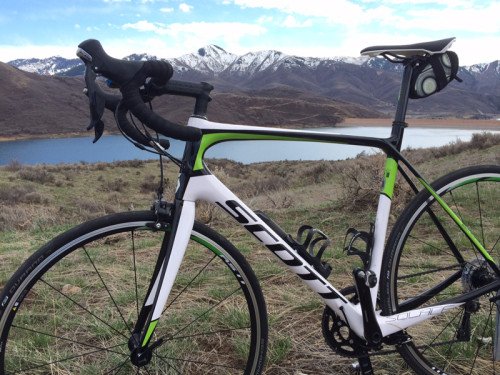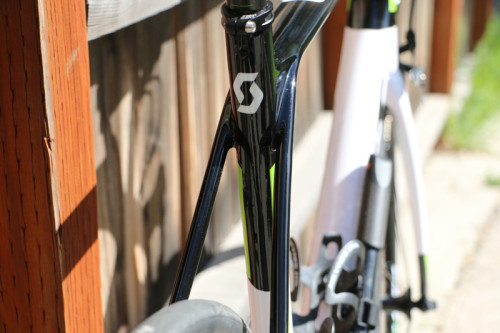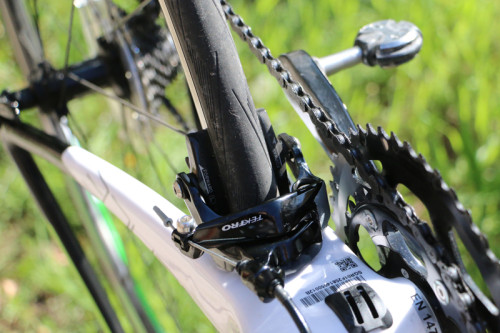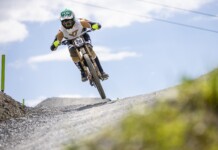
By Dave Iltis
I had the pleasure of testing out the Scott Solace 30 road bike this spring in the Salt Lake Valley and it excelled. I really didn’t want to give this bike back, I liked it that much. The Utah based international powerhouse bike manufacturer Scott Sports was kind enough to lend me the bike for an extended demo.
The bike is sharp looking, with white, green, and black graphics. The carbon construction is Scott’s lightweight IMP proprietary method, and yields a frame weighing 950g in a 54 cm model. The fork comes in at 330 g. It also uses a carbon steerer tube. The weight for a complete bike in a 54 cm (not the size I tested) is just shy of 18 pounds. I tested out an XL (58 cm) frame size.
After the sharp graphics, the first thing one notices after the sharp graphics on this bike is the lack of a brake bridge on the seat stays. This is because the rear brake has been placed underneath the chain stays (similar to the placement of mountain bike U-Brakes). This is a purposeful design feature as it allows the chain stays to be a bit more compliant than typical ones, and act as shock absorbers to smooth out the ride.
This smoothness has big benefits when riding – the feel of the bike is a little springier than the average carbon bike. Scott pitches the bike as more comfortable, and that it is, but it’s not a comfort bike. It’s a performance machine. It has a lively feel, a little more like a steel bike. The frame does a great job of absorbing rough spots in the road.

moved to below the chainstays. This provides greater shock absorption.
Photos by Dave Iltis
Scott designed the bike from top to bottom to improve comfort without sacrificing performance. In addition to moving the rear brake (see above), they made a number of design changes over a ‘standard’ frame. The downtube is wide, 66 mm, just above the bottom bracket. This helps to maintain lateral stiffness. Both the top tube and downtube are ovalized with a wider horizontal section. This improves the vertical compliance and provides more comfort, but also maintains lateral stiffness which means that more power is transferred from the pedals to forward motion. The seat stays also get this treatment, along with a taper from seat tube to rear dropout. Both of these add to comfort and maintain performance. The seat post diameter was also chosen carefully, and at 27.2 mm instead of the usual oversize 31.6, comfort is again improved.
Lastly, they also revisited fork design by adjusting the diameter of the fork blades by the front dropout to be a bit smaller and increasing it by the bottom of the headset. These adjustments both increase comfort and performance simultaneously.
The net result, when compared to the Scott Foil, is an increase in comfort of 30% in the frame, and 21% in the fork. Yet, the lateral stiffness is still high, this in part because the bottom bracket design is generally the same as the Foil and Addict.
Lastly, the frame is different for each size. Larger sizes have larger diameter tubes, smaller sizes have smaller tubes. Larger sizes have a bit thicker carbon layup too in order to maintain stiffness.
How did it ride?

moved to below the chainstays. This provides greater shock absorption.
Photos by Dave Iltis
The bike was great! The ride is smooth and predictable. And comfortable. But true to the design intentions, it’s stiff side to side, and power to the pedals is transferred cleanly to forward motion. On descents, the thing I noticed most is that the bike is stable. Very stable. This is no doubt a combination of the geometry – the bike has a 73.3 degree head angle – and frame construction. I felt confident descending at speed on it. The compliance also adds a bit of stability too as bumps in the road don’t affect the rider as much. The bike also climbs really well, no doubt because of the solid lateral stiffness.
One of the things I really liked about the bike is how well the XL frame size fit me right out of the box. Each rider is different, and adjustments to stem length, seat height and setback, and stem height are something everyone should pay attention too (and get a custom fit too). I’m 6’2”, and sometimes larger frames that fit me well are hard to find. Not the case here. The 57.5 cm top tube paired with a 205 mm head tube, and 120 mm Syncros stem left me feeling like I didn’t notice the bike – which is perfect. I wasn’t too low or cramped. Nor did I feel crunched either. What this means is that I could ride all day, and feel comfortable the whole time.
A note on the head tube height. Many larger bikes have short head tubes (in the 180-190 mm range). While this can be ok for some racers, and for some extra limber riders, the slightly taller head tube of the Solace translates to a little less fatigue on one’s neck, and perhaps a little more power from the lower back. It’s my belief that many race bikes are too low which, while increasing aerodynamics, can result in muscles that are applying power in perhaps a less than optimal way. The bike is targeted to the endurance rider, enthusiast, and introductory racer. The head tube is a little taller, and thus the rider is just a little higher on the bike. For myself, I felt like this improved stability. However, when cornering, it is just a little less precise than a high end race machine because of the higher center of gravity. In my view, this would only make a difference when racing criteriums.
Components: The Solace 30 comes with the Shimano 105 11-speed group. The compact crank and 11-32 cassette gives a huge gear range that will work anywhere from flats to Little Cottonwood Canyon. A Syncros carbon post, aluminum stem, and aluminum bars filled out the cockpit. The wheels are Shimano 16 spoke front, 20 spoke rear aluminum wheels. These are great for all purpose riding and training, and introductory racing, but for the higher level competitor, a set of carbon wheels would be in order.
The Shimano components work flawlessly, and it’s amazing that on a bike of this level (introductory racing/century rides) how well the components work. Even when compared to top of the line Dura-Ace from a few years ago.
The bike came stock with 25c Schwalbe Durano tires. While there is some debate regarding whether or not the 23c or 25c tires are faster, the 25c tires are definitely more comfortable. The tires ride really well. The frame easily fits the 25c tires, and from the looks of it, would handle 28c’s as well.
The one thing in the component pick that I didn’t care for much was the Syncros FL2.5 seat. It was a bit too minimal for my liking. But, seats are as different as the rider sitting on them. You may like it just fine. Try out a few if you don’t.
All in all, I would give this bike five stars. At $2149, you are getting a great bike that is perfect for the enthusiast, the endurance rider, the century rider, or the introductory racer.
For more information, and to find a local dealer, visit scott-sports.com









Hello there – I’ve read the article about Scott Solace (Scott Sports Solace 30) and I need your advice/help. I own the same model and I have managed to reduce its weight to 7 kgr with the pedals on. All the components have been replaced with top end ones (wheels, drivetrain etc). However, this is my first and only bike without having the opportunity to ride a pure racing bike or any other model. I am 48 years old and I started racing (around 100 km with 1,000 meters of elevation gain each race).
According to your experience, do you think that a pure racing bike would make that much of a difference? I have left just a small spacer above the head tube and I think that my position is relatively low on the drops (or at least at par with the majority of the amateur riders). My concern is if a pure racing bike would improve climbing and cornering significantly.
Any of your thoughts would be much appreciated.
Many thanks from Greece
John
Hi John, In my view, a pure racing bike would not improve climbing that much since you have already pared down the weight of your Solace. As for cornering, yes, you could see improvements due to a change in geometry. However, , if you are racing road races without a lot of corners, this might not be worth it. A pure racing bike would put you lower over your bars, but this does create some fatigue issues over longer distances. See if there’s someone who would allow you to ride their bike for a few miles and compare.
Comments are closed.